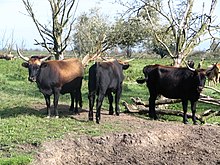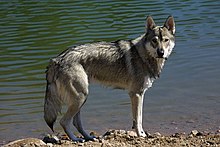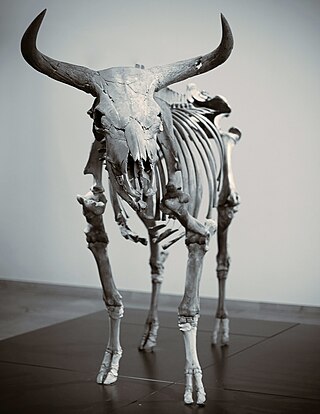
The aurochs is an extinct cattle species, considered to be the wild ancestor of modern domestic cattle. With a shoulder height of up to 180 cm (71 in) in bulls and 155 cm (61 in) in cows, it was one of the largest herbivores in the Holocene; it had massive elongated and broad horns that reached 80 cm (31 in) in length.
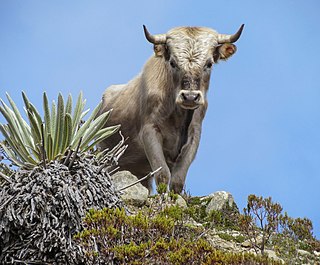
A feral animal or plant is one that lives in the wild but is descended from domesticated individuals. As with an introduced species, the introduction of feral animals or plants to non-native regions may disrupt ecosystems and has, in some cases, contributed to extinction of indigenous species. The removal of feral species is a major focus of island restoration.

The Heck or Munich-Berlin is a German breed or type of domestic cattle. It was bred in the 1920s by Heinz and Lutz Heck in an attempt to breed back the extinct aurochs. Controversy revolves around methodology and success of the programme. There are considerable differences between Heck cattle and the aurochs in build, height, and body proportions. Furthermore, there are other cattle breeds which resemble their wild ancestors at least as much as Heck cattle.

The Konik or Polish Konik is a Polish breed of pony. There are semi-feral populations in some regions. They are usually mouse dun or striped dun in color.

The term tarpan refers to free-ranging horses of the Eurasian steppe from the 18th to the 20th century. It is generally unknown whether those horses represented genuine wild horses, feral domestic horses or hybrids. The last individual believed to be a tarpan died in captivity in the Russian Empire in 1909.
Purebreds are "cultivated varieties" of an animal species achieved through the process of selective breeding. When the lineage of a purebred animal is recorded, that animal is said to be "pedigreed". Purebreds breed true-to-type which means the progeny of like-to-like purebred parents will carry the same phenotype, or observable characteristics of the parents. A group of purebreds is called a pure-breeding line or strain.

The domestication of vertebrates is the mutual relationship between vertebrate animals including birds and mammals, and the humans who have influence on their care and reproduction.

The Quagga Project is an attempt by a group in South Africa to use selective breeding to achieve a breeding lineage of Burchell's zebra which visually resemble the extinct quagga.

Ludwig Georg Heinrich Heck, called Lutz Heck was a German zoologist, animal researcher, animal book author and director of the Berlin Zoological Garden where he succeeded his father in 1932. A member of the Nazi party from 1937, he was a close hunting friend of Hermann Göring, and worked under him. One of his projects was the reconstruction of extinct animals such as the aurochs through cross-breeding of various modern breeds which he thought had parts of the original genetic heritage. Heck cattle and Heck horses are named for the resulting animal breeds.
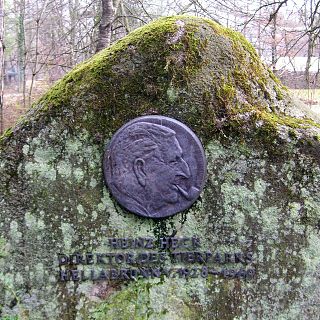
Heinz Heck was a German biologist and director of Hellabrunn Zoo in Munich. He was born in Berlin and died in Munich.
Wildwood Trust is a woodland discovery park in Herne, near Canterbury in Kent, England. It features over fifty species of native British animals such as deer, badgers, wild boar, wolves and brown bear. It is located on the main road A291 between Herne Bay and Canterbury.

The Mangalica is a Hungarian breed of domestic pig. It was developed in the mid-19th century by crossbreeding breeds from the nearby Romanian Salonta and Hungarian Bakony with the European wild boar and the Serbian Šumadija breed. The Mangalica pig grows a thick, curly coat of hair. The only other pig breed noted for having a long coat is the extinct Lincolnshire Curly Coat pig of England.

The Heck horse is a horse breed that is claimed to resemble the tarpan, an extinct wild equine. The breed was created by the German zoologist brothers Heinz Heck and Lutz Heck in an attempt to breed back the tarpan. Although unsuccessful at creating a genetic copy of the extinct species, they developed a breed with grullo coloration and primitive markings. Heck horses were subsequently exported to the United States, where a breed association was created in the 1960s.
Pajuna is a rare Spanish cattle breed, originating in Granada (Andalusia), which resembles the extinct aurochs, the wild ancestor of domestic cattle, in certain features.
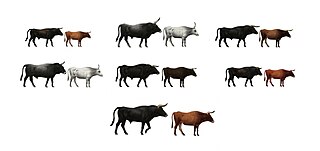
The Tauros Programme, formerly known as TaurOs Project, is a cooperation between the Dutch foundation Stichting Taurus and universities such as the Wageningen University and Research Centre. It is an international effort to breed a type of cattle that resembles the extinct aurochs, the wild ancestor of domestic cattle.
Stichting Taurus is a Dutch foundation which uses large herbivores grazing under natural circumstances for nature conservation. Robust cattle and horse breeds are used for this purpose.
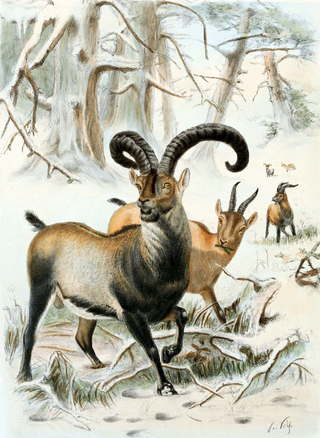
De-extinction is the process of generating an organism that either resembles or is an extinct species. There are several ways to carry out the process of de-extinction. Cloning is the most widely proposed method, although genome editing and selective breeding have also been considered. Similar techniques have been applied to certain endangered species, in hopes to boost their genetic diversity. The only method of the three that would provide an animal with the same genetic identity is cloning. There are benefits and drawbacks to the process of de-extinction ranging from technological advancements to ethical issues.

The Taurus Project of the German Arbeitsgemeinschaft Biologischer Umweltschutz aims to re-create the extinct aurochs, the wild ancestor of domestic cattle, by cross-breeding Heck cattle with aurochs-like cattle, mostly from Southern Europe. Herds of these cross-bred Taurus cattle have been established in Germany, Denmark, Hungary and Latvia, and are used in conservation of natural landscapes and biodiversity.
Wild ancestors are the original species from which domesticated plants and animals are derived. Examples include dogs which are derived from wolves and flax which is derived from Linum bienne. In most cases the wild ancestor species still exists, but some domesticated species, such as camels, have no surviving wild relatives. In many cases there is considerable debate in the scientific community about the identity of the wild ancestor or ancestors, as the process of domestication involves natural selection, artificial selection, and hybridization.
